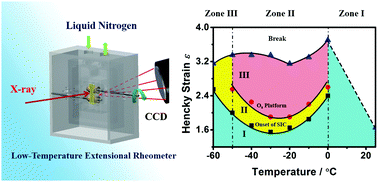Strain-induced crystal growth and molecular orientation of poly(isobutylene-isoprene) rubber at low temperatures†
Abstract
With the combination of a low-temperature extension rheometer and in situ synchrotron radiation wide-angle X-ray diffraction (SR-WAXD), the strain-induced crystallization (SIC) of poly(isobutylene-isoprene) rubber (IIR) was studied in the low-temperature region (−60 °C → 25 °C). The detailed structural evolution of IIR during the SIC is summarized in the strain–temperature space, where three distinct temperature zones are defined. The absence of the SIC in zone I (T > 0 °C) results in the poorest drawability of IIR among all measured temperatures. And with respect to the lowest temperature zone III (−60 °C < T < −50 °C), the SIC still occurs with low ultimate crystallinity (ca. 0.9%). More complicated structural evolution induced by the strain occurs in the intermediate-temperature zone II (−50 °C ≤ T ≤ 0 °C). The orientation ratio of the amorphous part Oa increases monotonically with the increment of the strain, but reaches a platform with Hencky strain ε > ca. 1.8. Meanwhile, the strain-induced crystal growth of IIR is evidenced by the dramatic increment of the lateral crystallite size of (110) and (113) planes. Moreover, the retraction experiment further reveals the network evolutions of IIR: suffering from low ultimate crystallinity (<ca. 9%), the network chain of IIR remains in series upon fracture. The current study clarifies the contribution of the SIC and molecular orientation to the self-enhanced mechanical properties of IIR at low temperatures.



 Please wait while we load your content...
Please wait while we load your content...